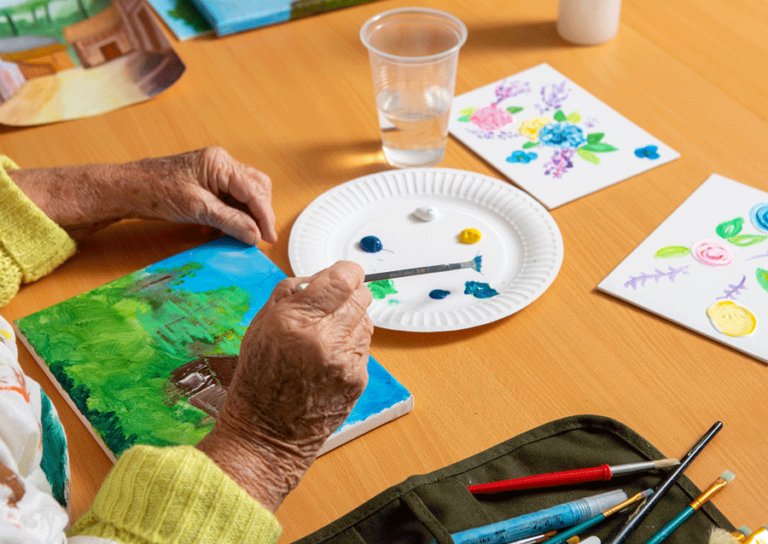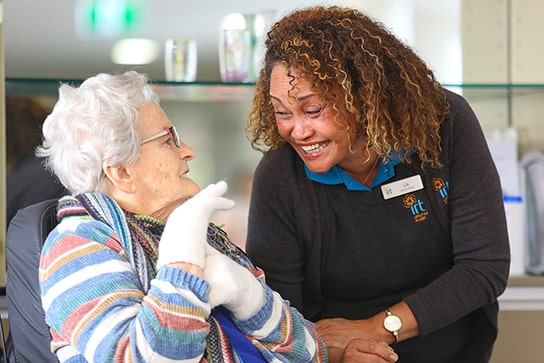Art as therapy in aged care: what you need to know
Here we explore the role of art as therapy in residential aged care, particularly for those living with dementia.

All human beings are creative by nature, but as we grow older many of us lose touch with our creative abilities. Raising families, pursuing careers and life itself can get in the way of exploring our creativity. But now there is growing recognition that creativity plays a vital role in maintaining our health and wellbeing as we age.
“Every child is an artist. The problem is how to remain an artist once we grow up.” - Pablo Picasso
Here we explore the role of artistic pursuits in residential aged care, particularly for those living with dementia, and look at some of the ways the aged care sector can embrace creativity to improve the lives of their residents.
Art as Therapy
Art and creativity can be therapeutic without needing to be formal arts therapy.
Residential aged care centres don’t provide arts therapy, which integrates art and clinical psychology. According to the Australian, New Zealand and Asian Creative Arts Therapies Association, arts therapists employ different creative methods to help clients explore their feelings, improve self-awareness and reduce anxiety. As such, an arts therapy session is very different from an art class or other creative activity.
However, that doesn’t mean artistic pursuits aren’t therapeutic in their own right. Creative and arts-based activities can have very positive impacts on physical and mental wellbeing.
Most residential aged care centres, including IRT’s, offer various activities for their residents, which can include arts and crafts, music, dance, writing, cooking and gardening.
Creative arts and dementia
According to the UK’s Mental Health Foundation, a review of 31 global studies found participatory art can help improve cognitive functioning, communication, self-esteem, musical skills, pleasure, enjoyment of life, memory and creative thinking in older people with dementia. Dr Louisa Smith, a research fellow at the University of Wollongong’s Australian Health Services Research Institute, has a particular interest in the value of creative pursuits for people living with dementia in residential aged care.
She leads the Care Connections stream of the Connections for Life with Dementia project, which is part of UOW’s Global Challenges Program.
Dr Smith urges the aged care sector to consider five things as they embrace artistic activities for their residents living with dementia:
1. Think about arts more broadly
Creativity can involve much more than painting and drawing and other conventional forms of art. Dr Smith views artistic activities as multi-modal forms of engagement that foster connection.
“The interim report of the current Royal Commission into Aged Care Quality and Safety is called Neglect – I think the opposite to neglecting is connecting, and creativity and arts give us a capacity to connect,” she says.
Across the globe there’s a growing creative ageing movement that embraces a whole range of artistic activities, including making something.
“It has involved reinvigorating men’s sheds, sewing circles, knitting circles – activities that people have done their whole lives and are still included in art-making,” Dr Smith explains.
She cites one example of a residential aged care centre that arranged for a tapestry to be created in a public space, over a long period of time.
“Family members, community members and people in the facility all contributed to the tapestry. They could do it whenever they wanted to, and engage with it whenever they chose.
“It became an incredible way of people relating and connecting to one another and that is one of the most powerful things about art and creativity – it is an avenue for connecting.”
That connection is often mediated by something familiar, something historic that people have done for a long time. Dr Smith says there are powerful examples of people with dementia being able to recall their historic creativity through engaging with an activity in the present. She tells the story of a woman living in a dementia unit who was disengaged with Dr Smith’s activity, which involved interacting with individualised sensory scarves.
“Then one day my colleague was wearing a tweed scarf. The woman said ‘I made that’, so I asked her what she meant. She said ‘I wove that tweed fabric’,” Dr Smith recounts.
It turned out the woman had worked in woollen mills for 20 years so Dr Smith gave her a tweed scarf and that was how she made a connection with her.
“For an hour she told us the whole history of working in the woollen mills. She wasn’t interested in engaging in craft-based activities but she loved talking about her profession.
“We all histories of making something, particularly in the Illawarra region where men and women worked in the steelworks and mines and used industrial skills in their homes.
“So many people have a rich creative history. We really need to support older people to enliven that history in the present.”
2. Tailor programs to individuals
Dr Smith says arts activities in residential aged care are usually designed by the aged care centre and offered to the residents as group-based activities.
“It might be water colours, collage or scrapbooking. Some people in that centre might be interested in those activities, but they don’t suit everyone.
“The reality is these activities work best when they’re based on the interests and passions of residents themselves and when they have a say in how they evolve.”
This approach aligns with the new Australian Aged Care Quality Standards, which highlight the importance of residents being able to make their own choices and for them be engaged in meaningful activities that are satisfying to them.
However, it is a departure from the way things have traditionally been done, so Dr Smith says there has to be top-down support for the change in approach.She acknowledges it can be challenging to design appropriate activities for people with dementia.
“You need to think about the activities that make them feel really comfortable within themselves and connected, and work out what supports they need to do those things.
“For someone it might be mowing the lawn; for someone else it might be knitting. For someone with dementia, if it is not in front of them and placed in their hands they’re probably not going to do it, but it doesn’t mean they don’t want to.”
She recommends creating a whole range of offerings, which she calls provocations.
“In a Montessori-based approach, a lot of things are placed around the person’s space which allows them to interact when they think it is appropriate, rather than at a set time.”
In this way the environment itself becomes a creative space because it holds a series of options. This challenges existing thinking because the space around people living with dementia is often cleared to protect them.
“We need to have some reverence for the capacity of the people with dementia to engage with rich environments.
“An environmentally impoverished space that doesn’t hold a lot of stimulus is more likely to lead to negative behaviours.”
Subscribe to our newsletter

Discover the benefits of pet therapy in aged care
3. Get to know the resident
There’s no doubt devising and supporting individual activities takes a lot of time, particularly for those with advanced dementia. That’s where a person-centred approach becomes critical.
It is really important to collect as much information as possible about a resident when they move in – their history and interests, likes and dislikes. That process usually includes talking to family and friends.
Dr Smith says the next step is to offer the resident a large range of curated options – different things they might engage with.
“Then watch what they choose to engage with and curate something that is bespoke. In this way the resident is actually designing their activities as they are going, as they are feeling, as they’re touching. So you are co-designing with them.”
Dr Smith and her colleague Dr Chantel Carr from UOW recently held an event at the UOW Maker Space which supported care staff and family members to think deeply about a resident and make something person-centred for them.
‘It was inspiring to see what this kind of creative imagination did. Every time I see the people who attended that workshop, they tell me something else they want to make for a person they support with dementia.”
4. Support the activity
It is not enough to identify and organise bespoke activities, there also needs to be a lot of support – or scaffolding – to help the resident enter into the activity.
“They need a facilitator to support them to enter the moment of doing that art,” Dr Smith explains.
This might involve creating a space without distractions, practical help – holding a brush, turning a page – as well as encouragement.
“This is a really productive way of supporting the wellbeing of someone with dementia because it enables connection and relationships with other people. And it supports them to be in the moment, which is when they are at their best.”
The resident will also need to be guided when the activity is complete.
“They need support to exit the activity – it might be as simple as saying: ‘Oh, look what we did. We’ve done this great artwork.’ And then later it’s important to relive the moment with them.
“So the facilitator really needs to guide them through the process.”
5. The resourcing challenge
Many aged care centres have activities coordinators who are responsible for planning the residents’ activities. Although this often involves group activities, Dr Smith says there needs to be a focus on individual activities as well.
“Some people find group activities overwhelming and for some people with dementia sitting with a group of 20 people can be cognitive hell.
“It takes skill to sit down, observe and work out what each resident will interact with, but the effort is worth it.”
Although it isn’t always possible for the carers themselves to find time to engage residents in creative pursuits, Dr Smith says there are many advantages if they can do so.
“It helps remind staff of who the resident is and they become more connected.
“Just tiny moments of creative connection and exchange make everyone feel better. Then the work is more satisfying and fulfilling for the carers.”
She cites another example involving the scarves. Hosting a range of sensory items, including photos, the scarves became a topic of conversation.
“The scarves changed the way staff and family interacted with the residents because it gave them something to talk about and I’d often see the staff sitting looking at photos attached to the scarves. It interrupted the personal care routine to allow them to connect.”
The role of volunteers in helping residents engage with creative pursuits is critically important and in many aged care centres volunteers are the facilitators.
“The volunteer sector, which we can completely underestimate, does amazing work,” Dr Smith says.
Dr Smith also believes there’s great scope for bringing the community to aged care centres as a way to increase access to a range of different activities.
“Rather than see the aged care centre as a place apart from the community, we can view it as a community hub. We need to find ways to link the residents in to community activities they used to enjoy.”
It could involve arranging for the local men’s shed, community choir, writers’ group or artists’ collective to visit the aged care centre to engage with the residents.
Dr Louisa Smith Smith is a Research Fellow at AHSRI and the School of Social Sciences at UOW. She does research with people with disabilities, including dementia, which aims to support participation, creativity and wellbeing. Twitter: @LouisaESmith1
Does your loved one need support?
IRT has been supporting older Australians and their families with compassionate care for more than 50 years with aged care centres in NSW, Qld and the ACT. If your loved one needs warm and personalised care you can trust, we'd be more than happy to help.
You may also like
Choosing an Aged Care Centre: What to consider
Moving from your home into a residential aged care centre can be a rewarding experience for you or your loved one.
Introduction to retirement villages
A retirement village is the perfect way to downsize your home and upsize your life.


